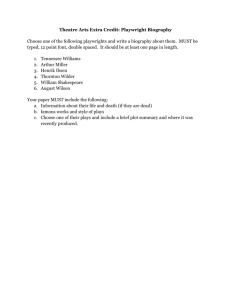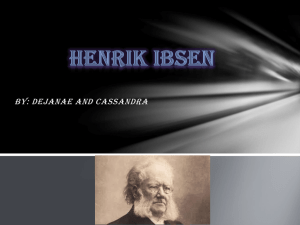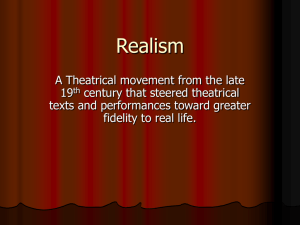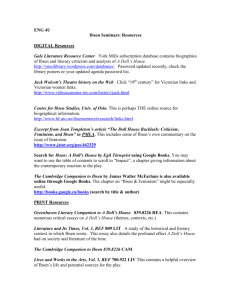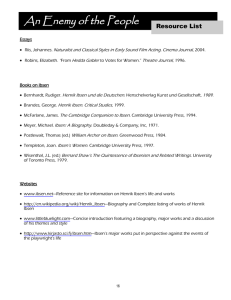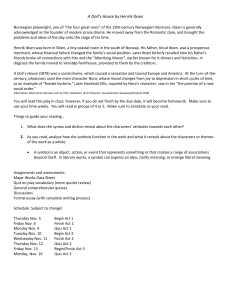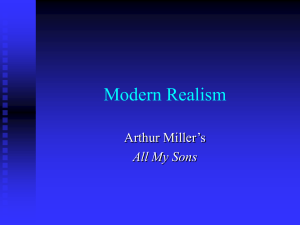Henrik Ibsen
advertisement
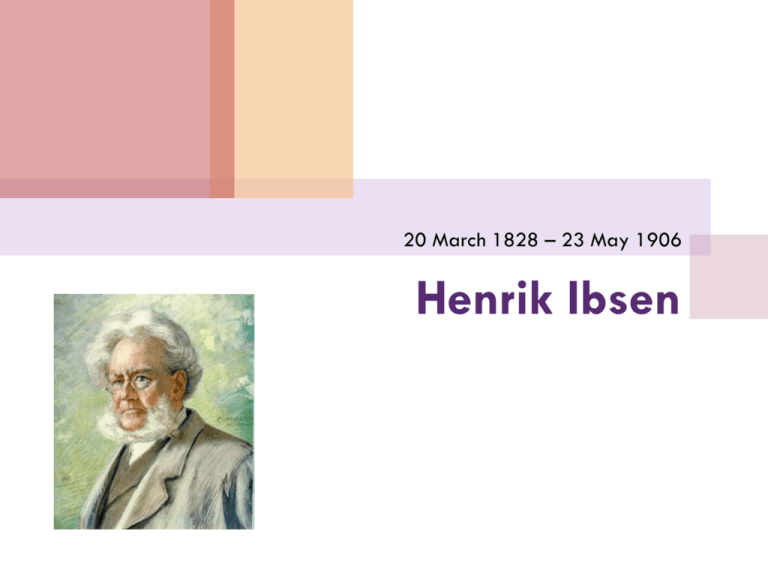
20 March 1828 – 23 May 1906 Henrik Ibsen Henrik Johan Ibsen (Norwegian pronunciation: [ˈhɛnɾɪk ˈɪpsən]) Major 19th-century Norwegian playwright, theatre director, and poet. Often referred to as the "father of modern drama.“ One of the founders of Modernism in the theatre. His plays were considered scandalous at the time, since they questioned Victorian values of family life. Ibsen's work examined the realities that lay behind appearances in life. Ibsen used a critical eye and free inquiry when looking into the conditions of life and issues of morality. Family and youth Henrik Ibsen was born to Knud Ibsen and Marichen Altenburg, a relatively well-to-do merchant family, in the small port town of Skien, Norway. He was a descendant of some of the oldest and most distinguished families of Norway, including the Paus family. Shortly after his birth his family's fortunes became very bad. His mother turned to religion for solace and his father began to suffer from severe depression. The characters in his plays often mirror his parents, and his themes often deal with financial difficulty and moral conflicts arising from dark secrets hidden from society Life At fifteen, Ibsen left home. He moved to the small town of Grimstad to become a pharmacist and began writing plays. In 1846, an affair with a servant produced an illegitimate child whom he later rejected. He never met his illegitimate son, who ended up as a poor blacksmith. Ibsen went to Christiania (later renamed Oslo) to study at the university. He soon rejected the idea (he did not pass all his entrance exams), preferring to commit himself to writing. Life His first play, the tragedy Catiline (1850), was published under the name of "Brynjolf Bjarme," when he was only 22, but it was not performed. His first play to be staged,The Burial Mound (1850), received little attention. Ibsen was determined to be a playwright, although the numerous plays he wrote in the following years remained unsuccessful. Life He spent the next several years at the Norwegian Theatre in Bergen, where he was involved in the production of more than 145 plays as a writer, director, and producer. During this period he did not publish any new plays of his own. Despite Ibsen's failure to achieve success as a playwright, he gained a great deal of practical experience that was to prove valuable when he continued writing. Life Ibsen returned to Christiania in 1858 to become the creative director of Christiania's National Theater. He married Suzannah Thoresen and she gave birth to their only child, Sigurd. They lived in very poor financial circumstances and Ibsen became very disenchanted with life in Norway. In 1864, they went to Sorrento in Italy in self-imposed exile. He was not to return to his native land for the next 27 years, and when he returned it was to be as a noted playwright, how ever controversial. Life His next play, Brand (1865), brought critical acclaim, along with some financial success, as did the following play, Peer Gynt (1867), with incidental music and songs by Edvard Grieg. With success, Ibsen became more confident and introduced his own beliefs and judgments into the drama, exploring what he termed the "drama of ideas." His next series of plays are often considered his Golden Age, when he was at the height of his power and influence, becoming the center of dramatic controversy across Europe. Life Ibsen moved to Dresden, Germany in 1868, where he spent years writing Emperor and Galilean (1873). He saw this play as the cornerstone of his entire work. Ibsen moved to Munich in 1875 and published A Doll's House in 1879. The play is a criticism of the acceptance of traditional roles of men and women in Victorian marriage. It is also about people freeing themselves from their restrictions. Life Ibsen followed A Doll's House with Ghosts (1881), another commentary on Victorian morality. In An Enemy of the People (1882), Ibsen went even further. Controversy became the primary focus, and the antagonist was the entire community. His next play again attacked unthinking beliefs and assumptions, but this time his attack was against reformers and their idealism. The Wild Duck (1884) is considered by many to be Ibsen's finest work, and it is certainly the most complex. Life In later plays such as Hedda Gabler (1890) and The Master Builder (1892) Ibsen explored psychological conflicts that went beyond a simple rejection of Victorian conventions. There are a few similarities between Hedda and Nora in A Doll's House. Ibsen returned to Norway in 1891, but it was not the Norway he had left. He had played a major role in the changes that had happened across society. The Victorian Age was on its last legs, to be replaced by the rise of Modernism in the theater and in public life. Death Ibsen died in Oslo on May 23, 1906 after a series of strokes. When his nurse told a visitor that he was a little better, Ibsen said "On the contrary" and died. He was buried in "The Graveyard of Our Savior” in Oslo. 2006, the 100th anniversary of his death was called the "Ibsen year" by Norwegian authorities. On May 23, 2006, the Ibsen Museum reopened his completely restored house with the original interior, colors and decor. Also in May 2006, a biographical puppet production of Ibsen's life named The Death of Little Ibsen debuted at New York City's Sanford Meisner Theater. Summary Ibsen rewrote the rules of drama with a realism which was to be adopted by Chekhov and others and which we see in the theater to this day. From Ibsen forward, challenging assumptions and directly speaking about issues has been considered one of the factors that makes a play art rather than entertainment.
